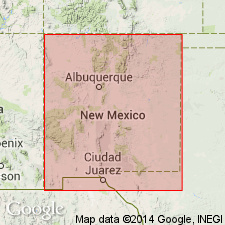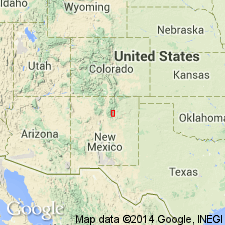
- Usage in publication:
-
- Alamitos Formation
- Modifications:
-
- Original reference
- Dominant lithology:
-
- Limestone
- AAPG geologic province:
-
- Palo Duro basin
Summary:
Pg. 10-14, 22 (fig. 6), fig. 10 (facing p. 30), pI. 1. Alamitos Formation. Name proposed for arkose and limestone sequence which overlies La Pasada and Flechado Formations (both new). Underlies red shales and arkoses of Sangre de Cristo Formation. Age is Middle to Late Pennsylvanian (Desmoinesian to Virgilian).
In Pecos area, thickness about 1,275 feet; is approximately equivalent to what has been called arkosic limestone member of Madera Limestone by Brill, 1952 (GSA Bull., v. 63, no. 8). Contact with underlying La Pasada is well exposed in upper part of Dalton Bluff section. It is placed at marked lithologic change from sequence composed primarily of limestone (upper half of La Pasada) to sequence with major percentages of arkosic sandstone and conglomerate (lower part of Alamitos).
In Rio Pueblo area, Alamitos retains over-all character of coarse-grained arkose, thickness about 4,000 feet. It is believed to be equivalent only to lower 500 feet of formation in Alamitos Valley and Pecos Valley, 40 miles to south. Both lower part of Alamitos and upper part of underlying Flechado are coarse-grained clastic units. Separation based on abrupt increase in feldspar from less than 3 percent in sandstones of Flechado to more than 30 percent in those of Alamitos.
Two measured sections designated as type section. (No single section exposes entire formation.) Primary type section exposes upper 1,000 feet, including contact with overlying Sangre de Cristo; top of Alamitos is placed at top of highest, well-developed limestone sequence. Secondary type section includes lower 1,200 feet. Formation poorly exposed at this section but locality is important because it provides contact with underlying La Pasada and lower 250 feet of formation which is not exposed in Alamitos Canyon.
Primary type section: Alamitos Canyon, San Miguel Co., north-central NM. Base of section begins at lowest exposure in bed of Alamitos Creek 4.2 mi by road northwest of U.S. Highway 85 and 2 mi northwest of concrete abutments at abandoned well.
Secondary type section: west of Pecos Valley on ridge between Pecos Valley and Alamitos Canyon, San Miguel Co. Base of section, which begins in La Pasada Formation, is about two-thirds of way up partly timbered slope on west side of north-trending dry valley due west of triangular erosional block west of Pecos River, 1.3 mi north of State Fish Hatchery on Highway 63.
Source: US geologic names lexicon (USGS Bull. 1350, p. 10); supplemental information from GNU records (USGS DDS-6; Denver GNULEX).

- Usage in publication:
-
- Alamitos Formation*
- Modifications:
-
- Areal extent
- AAPG geologic province:
-
- Las Vegas-Raton basin
- Palo Duro basin
Summary:
Is upper formation of Madera Group from near Las Vegas, San Miguel Co, Palo Duro basin to Mora, Mora Co in Las Vegas-Raton basin. Is a heterogeneous assemblage of gray to greenish-gray, silty, marly shale interbedded with arkosic sandstone, conglomerate, gray, nodular limestone, sandy arkosic limestone, and some thick-bedded limestone. Ranges from 180 ft (55 km) thick southwest of Montezuma to 1,285 ft (390 m) thick northwest of Sapello. Unconformably overlies Porvenir Formation. Unconformably underlies Sangre de Cristo Formation. Contains late Desmoinesian fusulinids in lower part and early Wolfcampian fusulinids near top. Fusulinids in middle are early Missourian. Has brachiopods, pelecypods, and gastropods of Late Pennsylvanian age. Considered to have been deposited in a marine to nonmarine fluviatile environment in Middle and Late Pennsylvanian into Early Permian time.
Source: GNU records (USGS DDS-6; Denver GNULEX).

- Usage in publication:
-
- Alamitos Formation*
- Modifications:
-
- Reference
- Dominant lithology:
-
- Shale
- Limestone
- Sandstone
- AAPG geologic province:
-
- Las Vegas-Raton basin
- Palo Duro basin
Summary:
[Preprint draft copy.] Alamitos Formation of Madera Group. Complexly interbedded shale, limestone and feldspathic to arkosic sandstone, and granule to pebble conglomerate. Is laterally and vertically heterogeneous, consisting of both marine and nonmarine rocks. Thickness ranges from 645 to 1,828 feet in southern and central parts of area, and 100 to 1,050 feet in northern part. Is top formation of Madera Group. Overlies Porvenir Formation of Madera; contact is unconformable locally. Underlies Sangre de Cristo Formation; contact is conformable, angularly unconformable, and disconformable locally. Fossils [listed]. Samples from study area yielded fusulinids representing the BEEDEINA (Desmoinesian), TRITICITES (Missourian and Virgilian), and SCHWAGERINA (Wolfcampian) zones; see fig. 54. Fusulinids indicate deposition began slightly later (late Desmoinesian) and continued slightly longer (early Wolfcampian) than at the Alamitos type section where age ranges from late middle Desmoinesian to Virgilian.
Reference section (section K): measured in roadcuts and hogback ridges just north of Highway 3 northwest and northeast of St. Joseph Church.
Mapped in southeastern Sangre de Cristo Mountains, Mora and San Miguel Cos., NM. Occurs in much of area except where removed by Cenozoic erosion, nondeposition, or erosion during the Late Pennsylvanian and Early Permian.
Source: Modified from GNU records (USGS DDS-6; Denver GNULEX).
- Usage in publication:
-
- Alamitos Formation
- Modifications:
-
- Revised
- AAPG geologic province:
-
- Las Vegas-Raton basin
- Palo Duro basin
Kues, B.S., 2001, The Pennsylvanian System in New Mexico; Overview with suggestions for revisions of stratigraphic nomenclature: New Mexico Bureau of Geology and Mineral Resources, New Mexico Geology, v. 23, no. 4, p. 103-122.
Summary:
Pg. 109. Alamitos Formation. Excluded from Madera Group. Consists of dominantly clastic facies and differs so greatly from typical lower Madera lithologies (=uniform, massive, cherty limestones) that application of term Madera Group is not recommended.
Source: Publication.
For more information, please contact Nancy Stamm, Geologic Names Committee Secretary.
Asterisk (*) indicates published by U.S. Geological Survey authors.
"No current usage" (†) implies that a name has been abandoned or has fallen into disuse. Former usage and, if known, replacement name given in parentheses ( ).
Slash (/) indicates name conflicts with nomenclatural guidelines (CSN, 1933; ACSN, 1961, 1970; NACSN, 1983, 2005, 2021). May be explained within brackets ([ ]).

